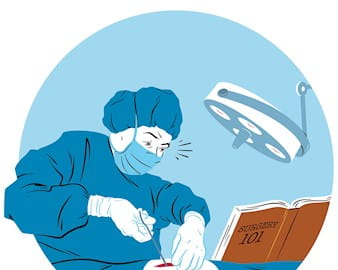
Leadership education spun on its axis in 1992, from theory and conjecture to action and results. The evolution began at Booth.
- By
- October 10, 2016
- Leadership

When the late Howard Haas became CEO of Sealy in 1967, he had been with the mattress maker for 11 years, seven of them in leadership positions. Over the next 19 years, he grew the company by an astonishing 17 percent a year, from $32 million in revenues to $550 million, without making an acquisition. He turned 34 different licenses into a unified brand and made Posturepedic a household name. Under his leadership, the company had the best return on capital in the bedding industry, and its in-store displays foresaw the stand-alone sleep store.
Haas learned to lead on the job, there being no graduate programs in leadership at the time. When he joined the faculty of Chicago Booth in 1988, two years after retiring from Sealy, the only leadership course taught at the school was professor emeritus Marvin Zonis’s Theories of Leadership. Haas spent hours in the Regenstein Library but could find nothing that spoke to his experience leading Sealy. He began to fill the giant “knowing-doing gap” with a new course called Leadership in Practice. Haas said he felt “like someone in the desert carrying a canteen of water to the very thirsty.”
Up to that point, curriculum at Booth had ridden the successive waves of leadership theory. In the early 1960s, when the late James H. Lorie, PhD ’47 (Economics), wrote his seminal paper, “The Chicago Approach to Business Education,” leadership education resided most often in military academies and colleges. Leadership was hierarchical and linear. There were leaders of tasks and leaders of men, all of whom were to be saluted and obeyed.
In 1968, when the late Thomas L. Whisler, MBA ’47, PhD ’53, then Booth’s director of research, predicted the future with his paper “Executives and Their Jobs—The Changing Organizational Structure,” leadership education at the school was “nonexistent,” in the words of Harry L. Davis, Roger L. and Rachel M. Goetz Distinguished Service Professor of Creative Management. The prevailing theory held that leaders were born, not made. A leader might rise in a given situation, according to contingency theorists, but unless the stars aligned, only those anointed by birth assumed the mantle of leadership. Business schools could not alter that trajectory.
“You first must be curious. Second, you try new things, you collect data, and you reflect on the data. It’s all very consistent with who we are as a school. This is evidence-based work.”
— Harry L. Davis
In 1982, Richard N. Rosett, then dean of Chicago Booth, maintained the “born, not made” theory. “The ability to lead a business depends largely on qualities of intellect and character that a good school can encourage and develop, but which must be present when the student is admitted to a school if they are to be there upon graduation,” he wrote. In that formulation, some students arrived with what were then considered key personality traits of a leader—vision, charisma, boldness—and left school better informed and more mature in their thinking, but not necessarily any better at leadership than their natural gifts already allowed. Those not born to leadership were simply out of luck.
By the early 1980s, the personal computer was Time’s “Man of the Year” and the term “information technology,” coined by Whisler, was a well-established phenomenon. His predictions about management in that decade—flatter organizations; computers replacing some jobs, transforming others; increased globalization—had proved prophetic, but executives were no longer almost exclusively men, as they had been in 1968. By 1985, 71 percent of women in America worked outside the home, almost half of them in professional careers and more than a third in management. In 1987, the first report on the glass ceiling—the forces preventing women from ascending to leadership roles—appeared. That same year, the Delors Commission signed the Single European Act, beginning the process of uniting what was then 12 members of the European Economic Community into a single trading bloc with a single currency. In 1989, the Berlin Wall fell, signaling the end of the Cold War.
As the times, organizations, management, and real-world leadership changed, leadership education raced to catch up. In 1989, Davis launched one of the first experiential leadership programs for full-time students at a leading business school. Three years later, he and fellow Booth professor Robin M. Hogarth, PhD ’72, published “Rethinking Management Education: A View from Chicago.” Leadership education would never be the same.
Business schools were “in danger of becoming irrelevant,” they wrote, unless MBA programs could respond to the vastly altered business landscape. They were not, of course, the only ones to notice the impending crisis. Other schools began to revamp their programs as well. But Davis and Hogarth dramatically transformed how Booth approached leadership and management education based on a fundamental insight: leadership should be taught in practice rather than in theory. They called for four specific changes that were unlike program modifications at competing schools, to ensure leadership training remained not only relevant but vital.
“Leadership keeps me up at night,” said Linda E. Ginzel, clinical professor of managerial psychology. “It is just so hard.” In part, what makes it difficult is the lack of an agreed-upon definition or a body of research on the subject. As a discipline, leadership lacks a home base. On the other hand, there is a lot of hot air. “I look at Amazon and do a quick calculation of how many books there are on the subject,” said Ruth Reiner, associate dean of leadership development for part-time MBA students. “We’re up to at least 50,000. They all claim to tell you what to do, but none of them tell you how.”

When the Davis-Hogarth paper was published, business schools mainly taught conceptual knowledge—accounting, statistics, marketing, the nuts and bolts of management, for example. Domain knowledge increased on the job as conceptual knowledge matured into an area of expertise. While Davis and Hogarth agreed with Lorie that “universities enjoy considerable comparative advantage in teaching conceptual knowledge,” they insisted that business schools go further. Given the acceleration of change, conceptual skills alone didn’t differentiate one business school from another. Davis and Hogarth broke with the past. They added action and insight to the skill types necessary for capable managers and leaders. Crucially, these skills could be learned, practiced, and developed in a career-long process of improvement.
“Being a leader is a skilled performance,” said Chris Collins, associate dean of leadership development for the Full-Time MBA Program. “It’s like being a surgeon. You can’t just read about it and then do it. You need intentional practice time to build those skills.”
Ultimately the challenge of leadership education is to teach how to turn ideas into action, how to move a group of people in a given direction based on a strategy. On the job, the risks of getting it wrong often constrain would-be leaders. A business school must become a place to experiment, Davis and Hogarth insisted, a safe place where students can try out new skills without blowing anything up.
The homeless discipline of leadership, however, is itself a concept. Booth is the ultimate quant school. Without data, who’s to know that anything happened? Leadership, therefore, has to move the needle; without verifiable results there is no proof that anything was learned. Ginzel, for instance, uses a number of visual devices to remind students to write down what happens—action skills, behavior changes, and outcomes—instead of just thinking about them. Davis’s students collect data via a mobile app, all with a view to a greater understanding of themselves as leaders.
“You first must be curious,” Davis said. “Second, you try new things, you collect data, and you reflect on the data. It’s all very consistent with who we are as a school. This is evidence-based work.”
“Too often students behave like passive customers,” Davis and Hogarth wrote in 1992. Students paid for a product and they expected it to be delivered, often with some entertainment thrown in. If it didn’t work, preferably immediately, it was a bad product.

By that time, MBA students were older on average than they had been when a graduate degree in business first became a career changer. They had more work experience. Their numbers were on the rise too, in the midst of a steady climb from 26,000 MBA degrees awarded in 1970 to more than 80,000 by 1995, according to US Department of Education statistics.
The two professors’ thinking derived, in large part, from what eventually became LEAD, a program for first-year students designed and led by second-year students. Shorthand for Leadership Effectiveness and Development (or Leadership Exploration and Development in the Evening MBA and Weekend MBA Programs), LEAD launched in 1989, after Davis reached out to current students to advise the faculty on potential changes to the curriculum.
LEAD is the only required course of all MBA students outside of the Executive MBA Program, which has other required classes. That requirement is unique to Booth among management schools. The goal, said Ginzel, is “to help students become self-sufficient learners in order to achieve higher levels of personal performance.”
“One of the principles of LEAD is that it is learner led,” Reiner said. “Adults learn better when they take accountability for their learning.” Having second-year students design and conduct LEAD for first-year students is itself an exercise in teamwork and successful execution, fostering interaction among students from different geographic, demographic, and professional backgrounds in their first quarter at Booth. “Leadership education here has been driven from the bottom up rather than the top down,” Davis said. “It creates quite a vibrant and creative stew.”
Having students help define their curriculum accommodates their differences in a single program. Engineers mingle with operational managers and accountants, so “we’re not going to be prescriptive,” Reiner said. “Our approach is more to create the container into which the student puts what makes sense for his or her goals.”
“It’s about bridging the knowing-doing gap. How do you make a conscious decision to do this instead of that?”
— Ruth Reiner
Booth accepts fewer than a fourth of all applicants, so it goes without saying that the students are highly intelligent and ambitious. Smart people who have done well in other school settings don’t always take well to experiential learning. The lack of structure and defined deliverables can be uncomfortable.

These are also people who are already successful to a great extent. Insisting that they challenge their assumptions, entertain outside opinions, and welcome feedback does not always go over well.
“The attitude is, ‘I’m a smart person,’” Davis said. “‘I got into a good school. I’m up for this great job. What do you mean I have things to work on? What do you mean I’m a lousy listener and should work on that?’”
Twenty years after writing the original paper, Davis and Hogarth revisited their ideas in 2012. They realized they had underestimated the extent to which “many managers did not want to acknowledge deficits in their action and insight skills, or that these deficits could be reduced through experimentation and practice.”
“The other reason that they balk,” Davis said, “is that some of their experiments will fail.” If you never fail, you haven’t experimented often enough, according to Davis.
In the last five years, Booth has become a place where it’s safe not only to experiment but to fail. Students are encouraged to focus on only one or two skills at a time rather than tackling the giant challenge of leadership all at once, to collect data and reflect on it before moving on to another small number of skills. The curriculum also strives to balance the short-term metrics on which so many managers are evaluated with the long-term payoffs of improved leadership skills.
Executive MBA student Christine Thomas was director of finance and controller of Zenoss, an IT-monitoring company based in Austin, Texas, when she enrolled in the program. A CPA with 10 years of experience, Thomas found that the leadership program “totally changed the way I approach my work. It’s noticeable. It’s an intrinsic part of what Booth gives you. It levels you up. It becomes part of who you are.” Thomas credits her changed approach for her promotion last November to vice president of finance, the company’s de facto CFO.
Effective leadership starts with very tough-minded self-examination. Financial results are not enough to win followers. The certainty and confidence of a leader come from self-awareness, a depth of understanding of who you are and what you stand for, what you’re good at, and where you fall short. This introspection and soul-searching is “usually revelatory, and often uncomfortable,” said Collins.

“We all love to think that we know ourselves very well,” Collins said. “We’re often wrong. Awareness of your style and your impact on others is a prerequisite for the choices you make. If you’re not aware that there’s another way to do something or ignore the impact that your actions will have, you’re paralyzed in what you’re doing, and you’re not free to choose how you want to lead.”
One module in LEAD separates students into groups of seven or eight. No one is the designated leader. The students are filmed while they spend half an hour working on a problem, followed by a discussion. Then they watch the film and undergo one-on-one coaching to analyze their effort. “It helps them see themselves as others see them,” Collins said. “They’ll say, ‘I thought I was leading but I hardly said anything.’ That kind of reaction.”
Ginzel’s “This I Believe” statement—a 300- to 500-word essay required at the beginning of her Leadership Capital course—asks students to state their fundamental principles. Students revisit those realistic personal assessments throughout the program and, indeed, throughout their careers. To that end, Ginzel’s students receive a workbook in which they are encouraged to make notes, with instructions to leave room for future reflections. “I want the workbook to serve them in the years ahead,” Ginzel said.
Booth’s leadership development courses grow out of behavioral psychology. “What we’re after is lasting behavioral change,” said Collins, a developmental psychologist. Reiner—an electrical engineer by training—agrees. “It’s about bridging the knowing-doing gap,” she said. “How do you make a conscious decision to do this instead of that?”
Ginzel’s classes exemplify the Booth approach to leadership: healthy doses of discussion, student input, introspection, and role-playing. In addition to enrolling in courses with experiential learning opportunities, students interested in leadership can add a practicum, a coached deep dive into a specific tactical skill.
One of Collins’s recent practicum students intended to start her own business. She worked with a coach on team building, everything from organizing a meeting to “harnessing the power of the group to make high-quality decisions,” he said. Another practicum student planned to enter a supervisory role for the first time and wanted to start off strong. He learned to resist giving feedback that was an exhaustive list of everything he had observed. “Subordinates just can’t handle it all at once,” Collins said. “He needed to focus on one or two important things.”
Of course, leadership education does not end upon graduation from Booth. Self-awareness and self-knowledge change with experience, so leadership has a lifelong learning curve. Christine Thomas, for instance, is currently being mentored by a LEAD coach to prepare for her transition to the executive team. “I needed a safe place to try things,” she said. “It helps me think through things, the things that I’m personally struggling with as a leader. I feel very free to say whatever I need.”
When Davis and Hogarth wrote their paper in 1992, graduate education risked irrelevance unless it was reinvented. They were all too aware that reinvention seldom lasts forever. Like businesses, the program had to be redesigned—even reinvented—on a continuous basis. This was the challenge for managers, a challenge that became even more urgent as technology advanced. Thus, the final puzzle that the two leadership education pioneers encountered: how to create a program that never needed reinventing. As the pace of change accelerated, traditionally slow-moving, consensus-building business schools had to evolve just as rapidly. Davis and Hogarth’s crucial insight: hardwire flexibility into the leadership education program.
The business problems facing students and alumni change with the times. No student in 1992 confronted Chinese currency manipulation or EU regulations or a robotized supply chain. By making students take ownership in their education via learner-led courses and by placing the onus for success on their behaviors, the school has been able to “help Booth MBAs leverage a lot of assets,” Collins said. “Our development work is not an off-the-rack proposition. Each student is quite different.”
Currently there are four parts to the leadership development program, but leadership education at Booth never sits still. “We keep learning and reinventing,” Reiner said. “We’re always looking to make sure we’re keeping up with current needs.”
Reiner earned her MBA at Harvard, famous for its case-study method. “It’s at the other end of the spectrum in terms of choice,” she said. “All my first-year courses were predetermined. Everything was taught via case method. At Booth, it’s based on rigorous analysis and data. A large percentage of the courses here are not solely case based. The faculty has complete autonomy to teach however they want. They teach what they’re most excited about.”
Leadership has evolved, as has leadership education. Some things do not change, however. Thomas Whisler’s slender book, Rules of the Game, published in 1984 to uncover the secretive world of boards of directors, gives some of the best advice for leaders then and now. “Be present, be thoughtful, be participative. This is not a spectator sport.”